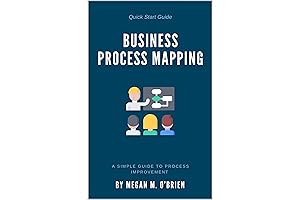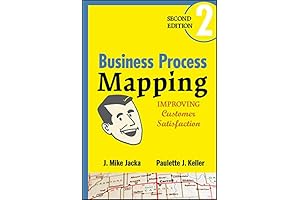· process mapping · 12 min read
Unveiling the Best Process Mapping Techniques for Optimal Business Performance
Elevate your business operations with our comprehensive guide to process mapping. Discover the essential techniques and strategies to streamlineworkflows, boost efficiency, and optimize outcomes.
Prepare to revolutionize your business processes with this in-depth exploration of process mapping. Learn how to optimizeworkflows, eliminate bottlenecks, and maximize productivity with our step-by-step guide. Whether you're a seasoned professional or just starting out, we've got you covered.
Overview

PROS
- Provides clear and concise instructions on how to create and use process maps.
- Features numerous real-world examples and case studies to illustrate the practical applications of process mapping.
CONS
- May not be suitable for advanced users who are already familiar with the subject.
- Could benefit from more in-depth coverage of advanced process mapping techniques.
The Basics of Process Mapping is a comprehensive guide that provides a structured and straightforward approach to process mapping. The book is divided into three main sections:
- Introduction to Process Mapping: This section introduces the concepts and benefits of process mapping and guides readers through the steps involved in creating a process map.
- Applying Process Mapping: This section provides detailed instructions on how to use process maps to identify and eliminate bottlenecks, improve efficiency, and enhance productivity.
- Case Studies and Examples: This section presents real-world examples and case studies to illustrate the practical applications of process mapping. These examples demonstrate how businesses have successfully used process mapping to streamline their operations and achieve their business goals.
Overall, The Basics of Process Mapping is an invaluable resource for anyone who wants to learn more about process mapping. Whether you're a business owner, manager, or process analyst, this book will provide you with the knowledge and tools you need to improve your workflow and boost your productivity.

PROS
- Unveils the intricacies of process mapping, process improvement, and process management through real-world examples
- Empowers professionals with hands-on techniques and practical advice to streamline workflows and eradicate inefficiencies
CONS
- May require a fundamental understanding of BPM (Business Process Management) concepts to fully grasp some sections
- Limited coverage of advanced process mapping techniques and methodologies
Delving into this comprehensive guide, professionals are introduced to the art of process mapping, a vital tool for optimizing workflows and enhancing information flow, enabling them to identify pain points, eliminate inefficiencies, and drive organizational excellence. The author's practical approach, coupled with real-world examples and hands-on exercises, equips readers with the knowledge and skills necessary to transform their processes.
This invaluable resource not only provides a thorough foundation in process mapping but also explores advanced concepts such as process improvement, process management, and performance measurement. By following the practical advice and implementing the techniques outlined in this guide, businesses can unlock the full potential of their processes, increase productivity, reduce costs, and gain a competitive edge in today's fast-paced market.

PROS
- Provides a comprehensive overview of process mapping concepts and techniques.
- Empowers individuals to identify and analyze key processes within an organization.
CONS
- May require additional resources for advanced process mapping applications.
- Examples could be more extensive to cover various process mapping scenarios.
The guidebook, "Understand Business Processes: A Guide to Process Mapping," serves as an accessible introduction to the world of process mapping. It adeptly lays the foundation for understanding the concepts and techniques involved in effectively mapping business processes. Whether you're new to process mapping or seeking to enhance your knowledge, this guide provides a valuable starting point.
One of the strengths of this guide lies in its ability to empower individuals to recognize and analyze essential processes within an organization. By equipping readers with the fundamental principles of process mapping, the guide enables them to actively contribute to process improvement initiatives. Additionally, the guide's emphasis on clarity and simplicity makes it an ideal resource for those seeking to gain a solid understanding of process mapping without getting bogged down in technical jargon.

PROS
- Ideal for optimizing your processes with easily customizable standard operating procedure templates
- Ease of use and visually appealing interface, with interactive worksheets and customizable templates
CONS
- Some sections may benefit from additional examples or case studies
- Primarily focused on standardization, rather than advanced analysis or process mapping techniques
For those seeking an efficient and structured approach to process mapping and standardization, this workbook emerges as a valuable asset. The provision of customizable standard operating procedure templates facilitates the smooth optimization of your processes. Navigating this workbook is a breeze, with its user-friendly interface, and the incorporation of interactive worksheets and customizable templates.
Furthermore, the emphasis on standardization empowers you to establish consistent and well-defined processes, boosting productivity and efficiency within your organization. Nevertheless, the inclusion of additional real-world examples or case studies would enhance the overall learning experience. Additionally, while it excels in standardization, it may not delve deeply into advanced analysis or comprehensive process mapping techniques.

PROS
- Streamlines process mapping efforts with clear and concise instructions.
- Empowers professionals with techniques to identify and analyze process inefficiencies.
CONS
- May lack depth for highly advanced process mapping practitioners.
- Additional examples could enhance comprehension for beginners.
Discover the fundamentals of process mapping with this comprehensive guide. Business Process Mapping empowers readers with a practical understanding of process analysis and improvement. Through real-life examples and step-by-step instructions, it demystifies the process mapping methodology, helping professionals identify and eliminate inefficiencies within their organizations.
This guide serves as a valuable resource for budding process analysts and seasoned professionals alike. Its accessible language and focus on practical application make it an indispensable tool for optimizing business processes and driving organizational excellence.

PROS
- Clear and concise guide to BPMN (Business Process Modeling Notation)
- Step-by-step instructions and practical examples for effective process mapping
CONS
- Lacks in-depth coverage of advanced BPMN concepts
- Examples could be more diverse to represent various industries
BPMN Quick and Easy is an accessible guide for anyone looking to understand and apply process mapping in their work. It provides a solid foundation in BPMN, making complex concepts understandable through lucid explanations and straightforward examples. The book's strength lies in its ability to walk readers through the process of creating BPMN diagrams efficiently, covering all essential elements of the notation.
Packed with real-world examples, BPMN Quick and Easy makes process mapping relatable and applicable to various industries and scenarios. Whether you're a beginner or seeking to enhance your BPMN skills, this book offers a practical approach to process mapping that can transform your understanding and empower you to create clear and effective process models.

PROS
- Provides a structured approach to mapping business processes
- Includes templates and worksheets for easy customization
- Empowers teams to identify and eliminate bottlenecks
- Enhances communication and collaboration across departments
- Supports continuous improvement and innovation
CONS
- May require some initial training to use effectively
- Can be time-consuming to complete complex process maps
The Business Process Mapping Workbook is an indispensable tool for organizations seeking to optimize their operations and elevate customer satisfaction. Its structured approach empowers teams to identify, analyze, and improve their business processes. The workbook provides a comprehensive framework, replete with templates and worksheets, enabling seamless customization to suit specific organizational needs.
By fostering a collaborative environment, the workbook facilitates effective communication and knowledge sharing among departments. It empowers teams to pinpoint inefficiencies, bottlenecks, and areas for improvement, thereby driving operational excellence. This comprehensive guide is highly recommended for organizations dedicated to continuous process optimization and delivering exceptional customer experiences.

PROS
- Structured approach to process improvement with hands-on templates and exercises.
- Data-driven insights help identify bottlenecks, optimize workflows, and enhance efficiency.
CONS
- May require additional training or resources for advanced process mapping techniques.
- Focus on data analysis could be less beneficial for processes with limited data availability.
Embark on a journey of process transformation with the Process Mapping Workbook, your indispensable companion for data-driven process improvement. This comprehensive workbook empowers you to thoroughly document your current processes, meticulously analyze them, and strategically design future states that drive excellence.
Packed with practical templates and thought-provoking exercises, this guide leads you step-by-step through the process mapping methodology. Harness the power of data to pinpoint inefficiencies, streamline workflows, and optimize your operations like never before. Whether you're a seasoned process professional or just starting your journey, this workbook serves as a valuable resource to unlock the full potential of your processes.

PROS
- Provides comprehensive guidance on creating impactful data visualizations.
- Offers practical techniques for presenting data effectively to diverse audiences.
CONS
- May require additional resources for complete understanding of advanced concepts.
- Specific examples and case studies could enhance the overall readability.
Delving into the realm of data visualization, this guidebook illuminates the art of transforming raw data into illuminating narratives. It unravels the intricacies of effectively presenting information through charts, graphs, and other visual aids, empowering readers to make informed decisions based on clear and compelling insights.
Through a structured process mapping approach, the guide adeptly walks readers through the intricacies of data visualization, ensuring that they grasp the fundamentals and can apply them seamlessly to their own projects. However, some advanced concepts may necessitate further exploration, and additional examples would bolster the guide's overall accessibility. Nevertheless, it remains an invaluable resource for scholars, researchers, and data enthusiasts seeking to elevate their data visualization skills and unlock the transformative power of visual storytelling.

PROS
- Comprehensive guide to process mapping, empowering businesses to streamline operations.
- Enrich customer interactions by identifying and eliminating pain points through process mapping.
CONS
- May require expert consultation for complex processes.
- Implementation can be time-consuming, demanding organizational commitment.
In the dynamic landscape of customer-centricity, 'Business Process Mapping: Improving Customer Satisfaction' emerges as an invaluable resource for businesses seeking to optimize their operations and unlock unparalleled customer satisfaction. This comprehensive guide provides a structured approach to process mapping, empowering organizations to identify and eliminate inefficiencies that hinder customer delight. By meticulously mapping out each step of a process, businesses can gain an in-depth understanding of customer touchpoints, pain points, and areas for improvement.
The book delves into the intricacies of process mapping, offering practical tools and techniques to facilitate a seamless implementation. With its emphasis on customer satisfaction, the guide encourages businesses to view processes through the lens of the customer, ensuring that every interaction aligns with their expectations. Through real-world examples and case studies, the author skillfully demonstrates how process mapping can transform customer experiences, driving loyalty and fostering long-term relationships. This book is a valuable asset for organizations committed to delivering exceptional customer service and achieving operational excellence in the modern business landscape.
Master the art of process mapping with our comprehensive guide. Discover proven techniques to map and analyze processes, identify improvement areas, and implement changes that drive success. Embrace process mapping as a powerful tool to enhance efficiency, reduce costs, and elevate business performance.
Frequently Asked Questions
What is the purpose of process mapping?
Process mapping visually represents business processes to analyze, improve, and optimize workflows, leading to increased efficiency and effectiveness.
How can process mapping benefit my business?
Process mapping empowers you to identify inefficiencies, eliminate bottlenecks, and streamline operations, resulting in improved performance, cost savings, and enhanced customer satisfaction.
What are the key steps involved in process mapping?
Process mapping involves defining the process scope, gathering data, creating a visual representation, analyzing the process, identifying improvement areas, and implementing changes.
How can I use process mapping to improve customer satisfaction?
Process mapping enables you to understand the customer journey, pinpoint pain points, and design improvements that enhance the customer experience, leading to increased satisfaction and loyalty.
What are some common challenges in process mapping?
Challenges may include resistance to change, lack of data, and the complexity of certain processes. However, with proper planning and stakeholder involvement, these challenges can be overcome.













